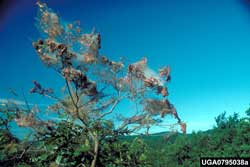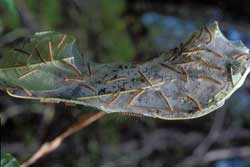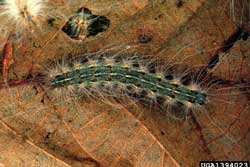Fall Webworm—Hyphantria cunea
The most notable aspect of this pest is the unsightly silken web that it produces. Many times, there are many of these webs per tree. These webs are started near the tips of the branches and gradually are extended down the branch towards the trunk. Although not considered a serious forest pest, the ugliness of the webs can cause them to be considered a significant pest of nurseries and landscapes.
Identification
Click on images to view full-size
Control Information
Factsheets
- Fall Webworm—Maine Forest Service
- Entomological Notes: Fall Webworm (PDF)—Penn State Cooperative Extension
Dig Deeper - Scientific Studies
- Biology and Management of the Fall Webworm, Hyphantria cunea (Lepidoptera: Erebidae)
Summary: This paper discusses the background history, biology, ecology, and management of fall webworm. This native pest is regulated naturally by host quality, parasitoids, and predators. Physical removal, biocontrol, and insecticides can be used to manage this pest.
More Information
- Maine Forest Service: Conditions Reports (updated regularly) including annual summary reports
Think First, Spray Last - Options for Hired Control
In Maine, the Board of Pesticides Control licenses pesticide applicators in several categories. Fall webworm control would fall under category 2 (Forestry) or 3A (Outdoor Ornamental). To find a licensed applicator in your area, you can search on the Board's website and search for the appropriate category.
[Photos, left to right: Ronald F. Billings, Texas Forest Service, Bugwood.org; Steven Katovich, USDA Forest Service, Bugwood.org; James B. Hanson, USDA Forest Service, Bugwood.org]


